|
Yarın
sabah 7de burada ol, hemen yola çıkacağız dediklerinde,
yolculuğa katılmak için henüz karar bile vermemiştim. İstanbula
gelen Viking gemisini duymuş, merak edip görmeye gitmiştim. Gemi
dört yıldır Baltık Denizi, İngiltere, Fransa ve bütün kuzey
Akdenizi dolaşmış ve İstanbula Kalamış marinasına gelmişti.
İlgilendiğimi görünce, ekipte dört kişi kaldıklarını, bir
kişiye daha ihtiyaçları olduğunu söyleyip onlara katılmamı
teklif ettiler. Yaz başı, bir Perşembe sabahı, saat 10 sularında
Kızkulesini arkamızda bırakmıştık bile. Boğazın şiddetli
akıntılarına karşı gemideki yandan sarkıtmalı küçük motoru
kullanıyor; o da yetmeyince küreklere asılıyoruz. Normalde motor
yalnız liman girişçıkışlarında ve acil durumlarda gerekiyormuş,
ama
ne rüzgar yelken |
|
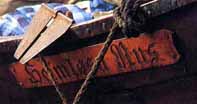
|
|
açmaya
elverişli ne de yalnız kürekler
yeterli. Boğazda akıntılar şiddetlendikçe kaptanımız Fredrik
Koivusalonun talimatlarıyla akıntının daha az olduğu karşı
kıyıya kürek çekiyor ve bu şekilde bir Asya bir Avrupa gidip
geliyoruz.
İstinyeye
vardığımızda saat artık öğleden sonra 2 olmuş ve günün ilk
yemek molasını hak etmiştik. Günlük rutine göre öğle
yemekleri salata ile geçiştiriliyor, varsa hafif bir beyaz şarap
buna eşlik ediyor. Tekrar yola çıktığımızda hedefimiz, geceyi
geçirmeyi planladığımız Poyrazköy. Fakat bir süre yol aldıktan
sonra sadece akıntılarla değil Boğazın |
|
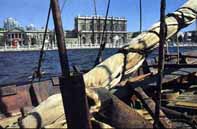
|
|
öğleden sonra kuzeyden esen rüzgarıyla da boğuştuğumuzu anlayınca
küçük, korunaklı bir koyda demirleyip akşamı beklemeye karar
veriyoruz. Poyrazköy limanına girdiğimizde saat akşam 8 buçuğu
gösteriyor. Boğazı geçmemiz bütün bir gün sürmüş.
Birisi
bana, bir gün boğazı kürek çekerek geçeceğimi; hem de 9. yüzyıl
modeli bir Viking gemisiyle bu işi yapacağımı söyleseydi
herhalde çok gülerdim. Aslında gemimize tekne demeyi daha uygun
buluyorum. Zira boyu 12 m, genişliği
3
m; üstelik kapalı bir kabin ya
da |
|
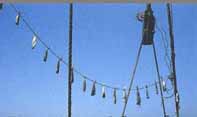
|
|
kamarası yok. 1976 yılında
Finlandiya körfezindeki Lapuri adasının yakınında bulunan bin yıllık
batık bir geminin kopyası bizimki. Adı Heimlösa Rus.
Evsiz-yurtsuz Rus anlamına geliyor. Kadim zamanlarda Araplar,
Vikinglere Rus derlermiş...
Bizim
tekne, bu akıl almaz projenin ikinci gemisi. Rus adındaki
ilk gemi Letonya açıklarında batınca bu ikincisini yapmışlar.
İşin asıl ilginç yanıysa, Vikingler 9. yüzyılda bu gemilerden
yüzlercesi ile gelip İstanbulu iki defa kuşatmışlar. Tabii,
bizim Heimlösa Rusun böyle bir niyeti yok!
Güzel
ve hakedilmiş bir uykudan sonra sabah limanda kahve kaynatıp sıkı
bir kahvaltı ediyoruz. Hava çok durgun ve kapalı. Bugünkü
hedefimiz Şileye, ormanlarla kaplı kıyı şeridini seyrederek,
yunusların eşliğinde, önemli bir sorun yaşamadan ulaşıyoruz.
Akşam gemimizin taştan yapılmış ocağında kızarttığımız
istavritleri afiyetle yiyip enerji depolarken gezi hakkında konuşuyoruz.
Bodrumdan
1 Mayısta yola çıkan ekip, iki hafta süren bir yolculuğun
sonunda vardığı İstanbulda, üç elemanını benim de dahil
olduğum yeni üç kişiyle değiştirip Karadeniz kıyısı boyunca
doğuya doğru ilerliyordu. Projenin hedefi, İneboluya kadar Türkiye
kıyılarından yol almak ve tekrar ekip değişikliği yaptıktan
sonra Karadenizi ortadan kuzeye doğru geçip Ukraynada Yalta
Limanına varmak, oradan da Azak Denizinden Rusyanın |
|
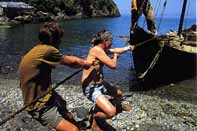
|
|
Kostov kentine ulaşmak. Kışın Rusyada kalacak gemiyle,
gelecek bahar kanallar yoluyla kuzeye çıkılacak; en sonunda da
yolculuğun başlangıç noktası olan Finlandiyaya dönülüp
proje tamamlanacak. Niye özellikle bu rota diye soracak olursanız;
amaç, Vikinglerin İstanbula kadar gelip Karadeniz üzerinden
süren, daha önce sözünü ettiğim uzun yolculuklarının bin yıl
sonra tekrarlanması. Üstelik, neredeyse benzer koşullarla... Bu yüzden
gezi, arkeolojik bir önem taşıyor.
Üçüncü
gün yolumuz uzun: Şileden Kefkene kadar gideceğiz. Şafakla
birlikte, saat 6da yoldayız. Kapalı hava öğlene doğru
açıyor. Biz de bunu firsat bilerek dünden tuzladığımız
istavritleri iplere gererek güneşe doğru asıyoruz. Gün oldukça
sakin devam ederken, kıyıyı bile zar zor seçebildiğimiz bir
yerde, birden birkaç eşek arısı musallat oluyor. Sadece birkaç
tane derken gittikçe kalabalıklaşıyorlar ve bir anda sayıları
yüzleri, belki binleri buluyor. Ekibin İsveçli üyesi Jan, katran
yakıp dumanıyla arıları kovymak istiyor ama neredeyse biz boğulacağız.
Sonunda başka çare olmadığını anlayınca yapılmaması
gerekeni yapıp bir katliama girişiyoruz. Biz birkaç yarayla
kurtulurken onlar yüzlerce ölü vererek pes ediyorlar.
|
|
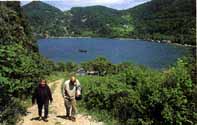
|
|
Gemi
Fin gemisi olmasına rağmen mürettebatta farklı ülkelerden
insanlar da oluyor. Yolculuğun bu bölümünde, kaptan Frednik
Koivusalo Finli ve esasen radyolog doktor. İsveçli Jan Mellning,
ülkesinde tarihi gemi restorasyonu yapıyor. Atso Leikas da Finli
bir gemi yapımcısı ve tamircisi. Ekipte Türkiyeyi temsilen
yalnız değilim: Kemal Saatçi, Kuşadası marinasında çalışıyor
ve Vikinglerimizle oradan tanışıyor. Ne yazık ki, yarın sabah
Kefkenden ayrılıp işine dönmesi gerekiyor. Proje tamamen gönüllü
katılımlarla gerçekleşiyor.
Dördüncü
gün yolculuğumuzun en uzun mesafesini kat edeceğiz. Niyetimiz
Kefkenden yola çıkıp Akçakocaya uğramadan, doğrudan
Karadeniz Ereğlisine varmak. Toplam 60 mil ediyor. Sabah hava
kapalı ve rüzgarlı. Denize çıkmadan önce en büyük korkum, -fırtınaları
saymazsak- deniz tutmasıydı; bugüne kadar hiç sorun yaşamadım,
ama bugün dalgalar hayli ürkütücü. Havanın kapalı olması ise
tam bir korku filmi atmosferi yaratıyor. Midem sabahleyin oldukça
fena durumdaydı. Biraz sabır, biraz sabır diyerek öğleyi
getirince ve hava açınca, kendime gelir gibi oluyorum.
|
|

|
Karadeniz
Ereğlisine yola çıktıktan ondört saat sonra akşam karanlığında
varıyoruz. Yöre halkı tarafından çok sıcak karşılanıyoruz;
herkes ilgili ve bizi rahat ettirmek için ellerinden geleni yapıyorlar.
O akşam balık eşliğinde rakılar içiliyor. |
|
Ereğlide
ekibe iki yeni üye katılıyor; ikisi de Finlandiyalı: Marja-Ritta
Topçu ve Seppo Suhonen. Marja-Ritta müzisyen ve sayesinde bundan
sonra gemimizde gerçek Viking müziği dinleyeceğiz.
Ertesi
sabah yüzüme düşen yağmur damlalarıyla uyanıyorum. Bugün
Janın son günü ve onu Zonguldakta bırakmamız gerekiyor.
Dalgalar insanı ürkütecek boyutlarda olmasına rağmen kaptanımızı
sevindiriyor; çünkü rüzgar lodos. Aslında bu mevsimde buralarda
lodosa pek rastlanmazmış. Ama şansımız uzun sürmüyor;
Zonguldakta girdiğimiz limandan, bu defa da fırtına yüzünden
çıkamıyoruz. Dalgalar karşımızdan öyle şiddetli geliyor ki,
burnumuzu dışarı çıkarmamıza müsaade etmiyor. Kaçırdığımız
her dakika için kaptan bize ve sağa sola bağırıyor. Sonunda
limandan çıkmayı başarıyoruz.
|
|
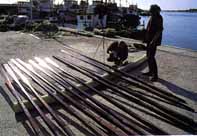
|
|
Bundan
sonraki hedef, geceyi geçireceğimiz Amasra. Uzun ve yorucu bir günün
sonunda gece 10 buçuk sularında Amasra limanına giriyoruz.
Gemimizi limana çektikten sonra kısa bir şehir turu yapıyoruz.
Bu kısa gezi sırasında bile Amasranın çekiciliğine kapılıyoruz
ve orada bir gün daha geçirmeye karar veriyoruz.
Ertesi
sabah kahvaltıdan sonra şehri ve çevresini gezmeye çıkıyoruz.
Amasranın gördüğüm en güzel ilçelerden biri olduğu düşünüyorum.
Kaptan
ve Marja-Ritta Amasra Lisesine davet ediliyorlar. Öğrencilere
gemi ve Vikingler üstüne İngilizce bir dersin ardından ekip sınıfla
birlikte gemiye geliyor. Bu ziyaret, çocukların İngilizce pratik
yapmaları için de çok iyi bir fırsat tabii... Marja-Ritta da yanındaki
Vikinglere özgü müzik aletlerini göstermekten keyif alıyor.
Sahilde akşam yemeğimizi hazırlarken herkes bizimle ilgili.
Meraklı bakışlar arasında Türk olduğum anlaşılınca soru yağmuruna
tutuluyorum; nerede yatıp kalkıyoruz, gemideki postlar ne postu,
yağmurda ıslanmıyor muyuz, üşümüyor muyuz, tuvalet ihtiyacımızı
nasıl karşılıyoruz, biz deli miyiz...
Gerçekten
de en çok sorulan sorulardan biri nerede nasıl yattığımız idi.
Gemide daha önce bahsettiğim gibi kamara yok. Önünde ve ardında
birer kişilik boş yer ve iki yanında 25-30 cm genişliğinde
boydan boya bank var. Bunların üzerine, kuzeyde soğuk iklimlerde
yaşayan elk geyiğinin postlarını serip onların üzerinde uyku
tulumlarımız içinde uyuyorduk. Belki inanmayacaksınız ama, uzun
süredir en rahat uykumu bu yolculuk sırasında, o bankın üzerinde
uyudum.
İşte
sekizinci gün de geldi ve yine yoldayız. Kaptanımız, sahil
boyunca, Karadenizin tam korunaklı üç doğal limanından biri
olan Gidenos (Sütlüce) koyunu arıyor. Sonunda birbirine benzeyen
kayalıklar arasında girişi buluyor ve koya giriyoruz girmesine
ama, çıkmak o kadar kolay olmuyor. Yeniden yola çıkarken
dalgalar öyle güçlü ki, başka bir teknenin yardımına ihtiyaç
duyuyoruz. Zorlu bir yolculuğun ardından, akşam hava kararırken
Cideye varıyoruz.
|
|

|
|
Heimlösa
Rus, tamamen kaptanımız Frednik tarafından yapılmış. Tahtaları
Finlandiyadaki ormanlardan kendi sağlamış; üstünde yattığımız
geyik postlarını kendi avladığı geyiklerden hazırlamış;
ipleri at kılından kendi örmüş. Kap-kacaklar tahtadan, her şey
orjinaline uygun şekilde hazırlanmış. Ancak, Heimlösa Rusu gören
deneyimli balıkçılar, yaptığımız işin pek akıl karı olmadığını,
bu tekneye fazla güvenilemeyeceğini söylüyorlar. Oysa bizimle
gelselerdi, düşünceleri hemen değişirdi. O kadar dalga yedik,
ama geminin denizden yalnızca 30 cm yüksekliği olan en alçak kısımlarından
bile içeri bir damla su girmedi. İnsan kendini bu gemide okyanusta
bir ceviz kabuğundaymış gibi hissediyor.
Artık
benim ve Marja-Rittanın gemideki son günü. Hedef İnebolu.
Onlar orada gerekli bürokratik işlemleri hallettikten sonra
Ukraynaya devam edecekler. Benim vize almak için vaktim ve param
olmadığından, ne yazık ki, İneboluda gezimi noktalıyorum.
Yolculuk
boyunca, özlediğim birkaç şey vardı sadece. Bunlardan en önemlisi
rakı kokmayan bardaklardı. Bardaklarımız tahtadan olduğu için
ilk içilen rakının anason kokusu iyice içine işlemişti ve
bundan sonra bir türlü bu kokudan kurtulamamıştık. Her içtiğimiz
şey aynı tattaydı. Benzer durum, çorbamız için de geçerliydi.
Nedense her yaptığımız çorbanın, domates olsun, sebze olsun,
rengi ve tadı aynıydı. Bunun nedenini bir türlü çözemedim. |
|
|
|
When
they told me to be there at seven oclock the next morning and
that they would set sail immediately, I had not actually made up my
mind to go with them. I had heard that a Viking ship had come to
Istanbul and gone to see it out of curiosity. |
|
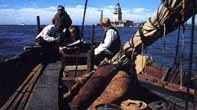
|
|
For
the past four years the ship had been at sea, sailing through the
Baltic and across the North Sea to England, from there to France,
and along the northern Mediterranean coast, finally arriving at
Kalamış Marina in Istanbul. When the crew saw I was interested,
they told me that they were down to four people and needed one crew
member. Would I join them?
At
ten oclock that Thursday in early summer we had already sailed
past Kızkulesi Tower at the southern mouth of the Bosphorus. In the
powerful currents
of the strait we had to use the |
|
small outboard engine to make
headway, and when that proved inadequate get out the oars. Normally
the engine was only kept for getting in and out of harbor and for
emergencies, but now there was not enough wind to use
the sails and |

|
|
rowing alone was impossible against the currents.
Whenever the current became too strong our captain Fredrik Koivusalo
instructed us to row towards the opposite shore, and in this way we
zigzagged between Asia and Europe.
At
two oclock we arrived at İstinye, halfway up the Bosphorus on
the European shore, and had earned the first meal of the day. The
daily routine was a lunch of salad, accompanied - when we had it -
by a light white wine. |
|
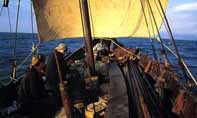
|
|
We
set out again, our goal being to reachPoyrazköy, where we would
spend the night. But a north wind was now blowing, and combined with
the currents all our efforts were in vain. We anchored in a small
sheltered bay and resolved to wait there until the wind dropped. We
set out again in the late afternoon and it was eight thirty when we
arrived in Poyrazköy harbour at the northern end of the Bosphorus.
It had taken an entire day to navigate the strait.
If
someone had told me that I would spend a day rowing up the Bosphorus
in a replica of a 9th century Viking ship, I would probably have
laughed. What we called a ship was actually only a tiny open boat,
12 meters in length and 3 meters wide. She was a copy of a one
thousand year old wreck discovered near the island of Lapuri in the
Gulf of Finland in 1976. Its name was Heimlösa Rus, meaning the
homeless Russian; since at that time the Arabs had referred to the
Vikings as Russians. |
|
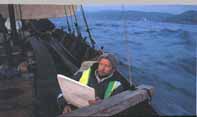
|
|
Our
boat was the second to have been built as apart of this incredible
project. The first, named Rus, had sunk off Lithuania, and this was
the second attempt. But what was really fascinating was that in the
9th century the Vikings had sailed to Istanbul in hundreds of such
ships and besieged the city twice. Of course the Heimlösa Rus had
no such intention!
After
a deep and much deserved sleep we boiled up some coffee and ate a
good breakfast before leaving harbor. The weather was windless and
cloudy. Today we aimed to reach Şile on the Black Sea coast.
Watching the forested shore and in the company of dolphins, we
reached this small fishing port without any serious difficulty. That
evening we fried horse mackerel on our stone hearth and as we ate
with relish, replenishing our store of energy ready for the next
day, we discussed the journey.
The
Heimlösa Rus had set out from Bodrum at the southeast extremity
of the Aegean on 1st of May and arrived in Istanbul two weeks later.
There three of the crew members had left to be replaced by myself
and two others. The next stage in the journey was to follow the
Turkish Black Sea coast to Inebolu. After that the ship would sail
due north across the Black Sea to the Ukrainian port of Yalta, and
from then through the Sea of Azov to the Russian city of Kostov.
There the ship would spend the winter, and next spring navigate the
canals back to Finland. If you wonder why this route had been
chosen, it was to trace the course |
|
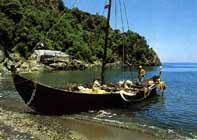
|
|
the
Vikings had taken one thousand years before, and as far as possible
under the same conditions. In this respect the journey was of
archaeological significance. The third day we had a long distance to
cover, from Şile to Kefken. We set out when dawn broke at six
oclock. The clouds dispersed around noon, and we took this
opportunity to string up the horse mackerel which we had salted the
day before to dry in the sun. The day was passing tranquilly when,
at a point where the shoreline was barely visible on the horizon,
some wasps started buzzing around us. More and more arrived until
suddenly there were hundreds, perhaps thousands. The Swedish member
of the crew, Jan, tried burning some tar on the theory that the
smoke would drive them away, but instead we started suffocating. In
desperation we embarked on a massacre. We emerged with a few stings,
but hundreds of wasps died in the battle and finally fled in
disarray. |
|
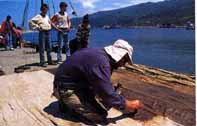
|
|
Although
the ship itself was Finnish, the crew were all volunteers from
various different countries. On this stage of the journey there was
our Finnish captain Fredrik Koivusalo, and a Swede, Jan Mellring,
who was a radiologist by profession but engaged in the restoration
of historic ships. Atso Leikas was a Finnish shipbuilder and
repairer. I was one of two crewmembers representing Turkey, the
other being Kemal Saatçi, who worked at Kuşadasi Marina where he
had met our Vikings. Unfortunately, he was due back at work, so had
to leave us at Kefken the following morning.
The
fourth day of our journey we had the longest distance of all to go.
Our plan was to set out from Kefken, pass by Akçakoca without
calling in port, and reach Eregli, a journey of 60 miles in all.
That morning the weather was cloudy and windy. Before joining the
ship my greatest fear, apart from storms, had been seasickness. I
had been all right so far, but today the waves were alarmingly
large. The heavy cloud cover contributed to create the perfect
atmosphere for a horror film. That morning my stomach was suffering.
Gritting my teeth I survived until noon, when the sun came out and I
returned more or less to normal. |
|
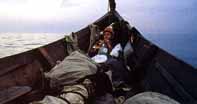
|
|
We
arrived at Eregli after fourteen hours at sea. Night had already
fallen, but we were given a warm welcome by the local people, who
did all they could to make us comfortable. That evening we ate fish
accompanied by raki.
At
Eregli two new crewmembers joined us. Marja-Ritta Topcu and Seppo
Suhonen were both Finnish. Marja-Ritta was a musician, and thanks to
her we were to listen to real Viking music on our ship from now on.
The
following morning I awoke to rain drops falling on my face. Today it
was Jan S last day. He was to leave the ship at Zonguldak.
Although the waves were of menacing size, our captain was delighted
because of the southwesterly wind. Apparently southwesterlies were
rare in this season. But our luck was not to hold. Having entered
Zonguldak harbor a storm broke out, preventing us from leaving. The
waves were rolling at us with such violence that we could not get
out of the harbor mouth. For every minute lost the captain shouted
at us and at the storm.
Finally
we made it into the open sea, and set sail for Amasra where we were
to spend the night. After a long and exhausting day we arrived in
Amasra harbor around ten thirty at night. We moored and took a brief
walk around the town. That was sufficient to enchant us, and we
decided to spend the next day there.
The
next morning after breakfast we set out to tour the town and its
environs. Amasra was one of the most delightful towns I had ever
seen. The captain and MarjaRitta were invited to Amasra High
School to give the pupils a lecture in English about the ship and
the Vikings. After that they brought the whole class to see the
Heimlösa Rus. The visit was a good opportunity to practice their
English, and Marja-Ritta enjoyed showing them the Viking musical
instruments which she had brought with her. |
|
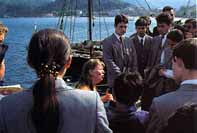
|
|
As
we prepared our evening meal on the shore, a curious crowd gathered.
When they realized that I was Turkish, I was subjected to a
bombardment of questions. Where did we sleep? What animal did those
fur pelts belong to? Didnt we get wet when it rained? Didnt we
get cold? What did we do without a lavatory? Were we idiot? The
question about sleeping arrangements was asked most often. As I have
already said, the ship was open with no cabin. In the stern and bow
were spaces each large enough for one person to lie down, and along
the sides were benches for the others. We slept in sleeping bags on
elk skins, and perhaps you will not believe me, but I slept more
comfortably on that bench than I had done for a long time.
The
eighth day had arrived, and we were off again. The captain was
looking for the bay of Gideros (alias Sütlüce), one of just three
sheltered natural harbors on the Turkish Black Sea coast. Finally he
discovered the entrance concealed amongst identical looking cliffs,
and we got in, but getting out was a different matter. As we resumed
our voyage the waves put up such a determined resistance that we
needed the help of another boat. After a difficult journey we
arrived in Cide at nightfall.
The
Heimlösa Rus was constructed entirely by our captain Fredrik.
Moreover, he had felled the timber himself in Finland forests, the
elk skins were from elk he had hunted himself and the ropes he had
woven himself from horsehair. The barrels for food and water and
other accessories were made of wood and identical to those used by
the Vikings. Experienced fishermen who saw the Heimlösa Rus
commented that the boat was unseaworthy and that we were putting
ourselves in danger. Yet if they had been with us, they would have
changed their minds. We had sailed through rough seas, yet not a
drop of water had entered the boat, which at its lowest point was
just 30 cm above the waterline. It had felt like being in a walnut
shell tossed about on the high seas.
It
was the last day on the boat for Marja-Ritta and I, as we made for
Inebolu. There the rest of the crew was going to complete the
necessary formalities for leaving Turkey and continuing on to
Ukraine. Since I had had neither the time nor the money to obtain a
visa, Inebolu was unfortunately the end of the journey for me.
All
through the journey I had missed just two things. The most important
was cups which did not smell of raki. Since our cups were made of
wood, the first time we had drunk raki from them they had absorbed
the smell of aniseed ineradicably, and everything we had drunk since
had tasted the same. My second complaint was the soup, which also
tasted the same every time. For some unaccountable reason, every
soup we made, whether tomato or vegetable, had precisely the same
color and flavor. Why, I still have no idea. |
|